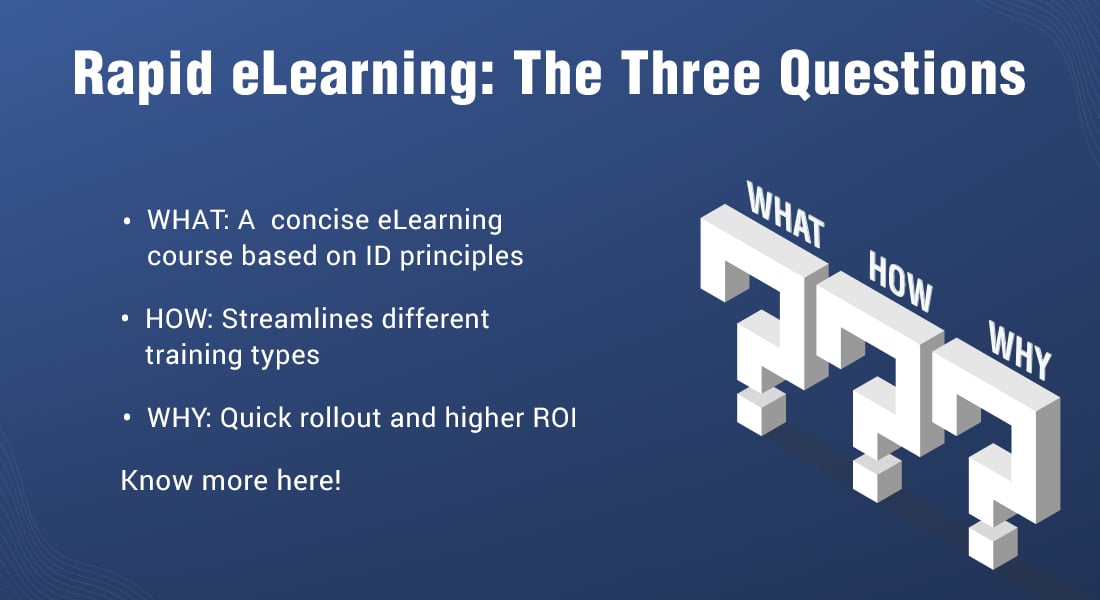Rapid E-learning: Meeting the Training Needs of the 21st Century

Rapid eLearning – a methodology that has become synonymous with online course development. Why are companies using it? What are the benefits of rapid eLearning methodology? How can it effectively satisfy the dynamic training needs of organizations?
→ Download Now: Rapid eLearning — The 4 Rs for Corporate Training Success
Before we see why rapid eLearning is so useful, it is important to understand the changes in the business environment and the new training needs that have emerged as a result.
Developments that had a major impact on companies
The last 25 years have witnessed four revolutionary developments that have altered the corporate landscape.
- Globalization of business
- Growth of competition
- Developments in Information and Communications Technology (ICT)
- Increase in the number and kind of products
Let us now analyze the significance of these changes
Importance of globalization on organizations
As more companies began to seek new opportunities in new markets overseas, new business needs began to emerge. These are some of the changes unleashed by globalization on the word of business.
- Adapting to new social and cultural environments
- Training workforces that speak multiple languages effectively
- Complying to local laws and statutes
Role of enhanced competition on companies
The fierce competition prevailing in the marketplace is forcing companies to orient their strategies towards
- Reduction in cost
- Improving production and sales efficiency
Influence of developments in the ICT sector on firms
Various developments in the ICT sector such as the phenomenal growth of the Internet and mobile device users has provided new opportunities to companies. These technologies help companies to:
- Reach out to new customers
- Conduct their business operations efficiently
- Effectively train the workforces
Effects of increased number of products on businesses
The number of products available in markets worldwide increased dramatically due to the evolution of new customer needs, their changing preferences and so on. This resulted in the birth of two major business needs.
- Continuous and faster product launches to remain in fray
- High levels of customer satisfaction
These changes had a major impact on eLearning. Let us now examine the influence of these factors on online training.
New training needs that arose due to changes in the business environment
Demand for low-cost courses
As companies focus more on reducing costs than ever before, training budgets are shrinking and the demands for optimal use of the training dollar are increasing. Organizations no longer want high-priced online courses that are rich in interactivities, but have started to opt for utilitarian courses, which could satisfy their needs at reduced costs.
Need to develop courses quickly
Today, companies need to train their staff quickly and effectively to meet the ever-changing demands of the marketplace. Delay in training can result in serious performance issues and may even threaten the very existence of an organization. For example, not being able to train sales personnel effectively on a new product at the right time may land a firm in serious trouble.
Growing need for translation of online courses
As companies began to expand their business to multiple countries, the need to impart effective training to these global workforces in their native languages became more pressing. Companies are increasingly translating their online courses from English into different languages to meet this need.
Spurt in the use of mLearning
According to a study conducted by Morgan Stanley Research, more people would access the Internet through mobile devices than through desktop computers by 2015. This phenomenal rise in the use of mobile devices has made a large number of organizations opt for mobile learning solutions. The American Ambient Insight Report (2011) reports that the number of companies seeking mobile learning solutions is growing at an annual rate of 29.3%.

Have You Met the 4 Rs of Rapid eLearning?
Accelerate Learning and Maximize its Impact With the 4 Rs of Rapid eLearning!
4Rs of rapid eLearning:
- Redesign
- Record
- Rebuild
- Republish
Increasing significance of bite-sized learning
The growth of mLearning has resulted in the need to build smaller courses that can be effectively accessed on mobile devices. Long courses spanning 2-3 hours have given way for bite-sized learning modules. Another aspect that has resulted in the growth of bite-sized learning was that these short courses facilitated better learning. Human memory is short and it is easy to retain content when it is delivered in small chunks rather than ‘dump’ it in one big course.
It was clear that the traditional approach to eLearning development could not meet these requirements. A new methodology was needed and Rapid Elearning was the answer to this need.
How does Rapid eLearning satisfy these needs?
Let us now see how rapid eLearning can be used to effectively meet the changing learning needs of organizations.
Development of courses in short durations
As the name suggests, Rapid eLearning can be used to cut down development time of online courses drastically. It is possible to develop courses in 40% less time than it would take to develop courses using the traditional methodology.
Here is a comparison of the traditional methodology and Rapid Elearning that gives you a brief idea of why online courses can be developed fast using the new online course development methodology.
| Rapid | Traditional |
| 1. Identifying the existing content | 1. Analyzing content |
| 2. Content briefing | |
| 3. Storyboarding | |
| 4. Designing GUI and navigation | |
| 5. Design interactions | |
| 2. Identifying existing media | 6. Creating media |
| 3. Development of courses using rapid authoring tools | 7. Development of courses using traditional authoring tools |
| 4. Adding assessments | 8. Adding assessments |
| 9. Review | |
| 5. Deploy | 10. Deploy |
Thus, we see that rapid eLearning helps organizations to develop courses faster and meet their learning needs on time.
Delivery of maximum ROI on training
We have seen that Rapid eLearning squeezes instructional design and development phases. This goes a long way in reducing the development costs. This methodology can produce online courses for as less as 50% when compared to its traditional counterpart. Indeed, organizations can now optimize their training dollar.
Production of mobile-compatible courses
We have seen the growing significance of mobile learning in today’s corporate training world. Rapid eLearning effectively satisfies the need of companies to develop courses that can be effectively accessed on these gadgets. Unlike the traditional approach that is primarily based on Flash, which cannot be used to develop mobile compatible courses, the new methodology is centered on rapid authoring tools – tools that can publish courses to HTML5, a format that is highly mobile-friendly.
Creation of instructionally sound courses
In addition to satisfying the learning needs of firms effectively, Rapid eLearning methodology can be used to develop courses that are instructionally sound because it facilitates the participation of Subject Matter Experts (SMEs) and Instructional Designers (IDs) in the development of online courses. This is possible because little coding skills are needed to use rapid authoring tools.
Updates to courses are easy to make
It has been rightly remarked that change is the only constant in the world of business. Courses need to be regularly updated to meet the ever-evolving training needs of organizations. Rapid authoring tools allow companies to update courses quickly and effectively. SMEs can update the courses themselves without any assistance from developers.
Thus, we see that rapid eLearning satisfies the dynamic needs of companies. Indeed it is THE online course development methodology of the 21st century. What do you think?





